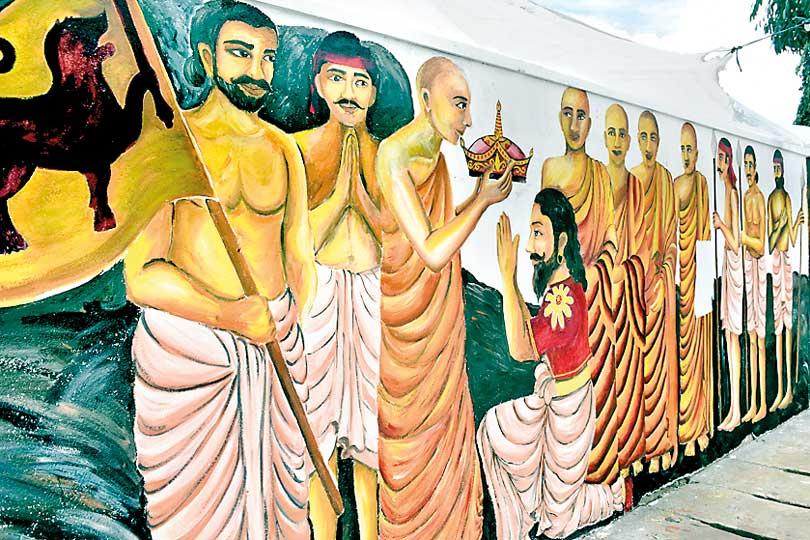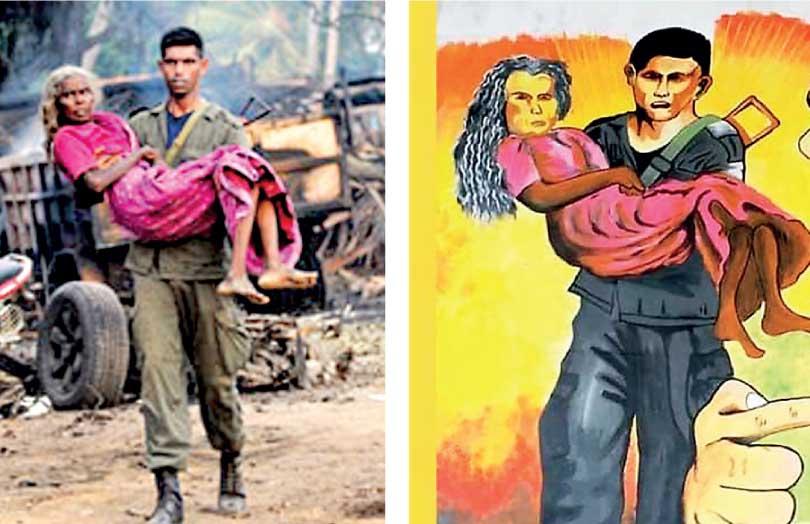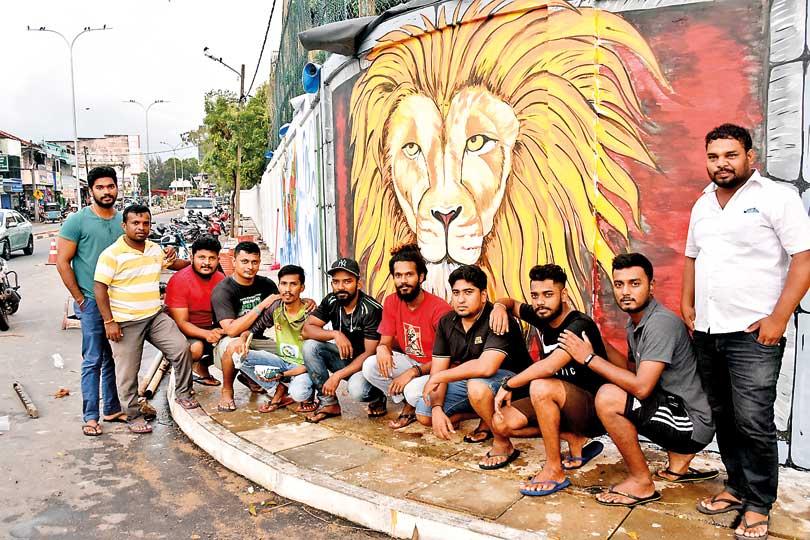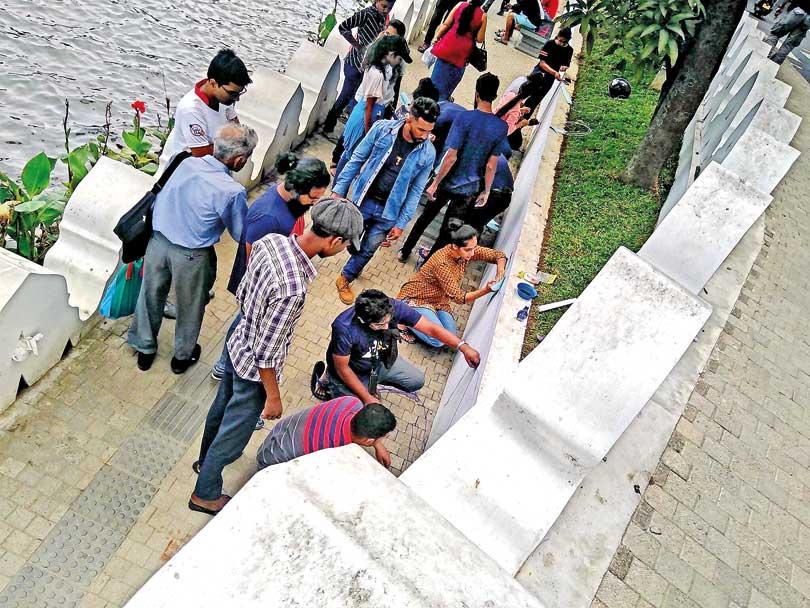18 Dec 2019 - {{hitsCtrl.values.hits}}

Street art depicting the history of Dambulla
 Days before the new regime secured power Sri Lanka witnessed many changes, one of them being the much-spoken-about street art trend. Today, every nook and corner of the island is being transformed into a work of art under different themes. But art is not only about colours and figures. Quality, structure and attention to detail also come into play. As such, the new wave of street art currently trending in Sri Lanka has received mixed reactions from people. While some appreciate the work, others feel that they don’t meet the standard.
Days before the new regime secured power Sri Lanka witnessed many changes, one of them being the much-spoken-about street art trend. Today, every nook and corner of the island is being transformed into a work of art under different themes. But art is not only about colours and figures. Quality, structure and attention to detail also come into play. As such, the new wave of street art currently trending in Sri Lanka has received mixed reactions from people. While some appreciate the work, others feel that they don’t meet the standard.
On an unprofessional note, certain original work too were reproduced without obtaining consent from the original artist. Some paintings don’t serve any purpose while some images have been distorted. Apart from that there is no regulatory mechanism established as yet to ensure that the paintings aren’t distorted, copyrights aren’t violated and that they would be maintained. As a result, much of these artwork is being done in places such as the Clouds Wall (Walakulu Bamma) at the Kandy Lake Precinct and under the Dehiwela flyover, covering the hazard marker signs. With that in mind Daily Mirror spoke to a few professional artists and freelance artists in some towns to find out what they feel about this new wave.
Although graffiti is considered to be an art form in the popular culture, it originated during the Paleolithic period. Early civilizations made use of symbols carved on caves and other materials as means of communicating with one another. As such Petroglyphs are considered to be the first form of graffiti which are created on a rock surface by incising, carving and abrading it. Sri Lanka too has several examples including Sigiriya Frescoes while being home to several mural artists including David Paynter, George Keyt, Solias Mendis and new generation artists including Isuri Dayaratne. During World War II, ‘Kilroy was here’ was a graffiti phenomenon that flourished across the globe followed by the construction of the Berlin Wall which is a perfect example of modern graffiti. Around the 1980s, graffiti was seen in many hip-hop tracks and it still has strong ties to this culture. Along with DJing, MCing and breaking, graffiti became a central part in hip-hop culture which could be traced back to Bronx in New York. From NYC graffiti art was then seen in London, Paris, Rome and many other countries. By the 20th century it had further advanced into a mode of communication between people. One of the 20th century artists that gained much popularity for his satirical work was Banksy. His street art and subversive epigrams combine dark humour with graffiti executed in a distinctive stenciling technique. Today graffiti art is one specialization in modern art and has taken its place in the popular culture. Many artists use spray paints, stencils, stickers and new techniques for their creations.
 \
\
Before and after comparison of the original photograph (left) and the painting (right)
Prasanna Weerakkody is a Sri Lankan artist and painter specializing in ancient Sinhala lifestyle and warriors who recently complained that his original artworks were reproduced as street art without his consent. “I have been working on a special project to reproduce Sri Lankan history through detailed paintings,” he said while speaking to Daily Mirror. “It was a project that required much dedication with one piece sometimes taking two or three years to complete. My references have been books and information collected at museums. Every incident that happened in history is being reproduced on canvass. I don’t have artwork to refer to and all these paintings were done solely using my imagination. But I didn’t publish many of these arts due to copyrights issues. People need to be proud about the country’s history and my objective was to highlight it through art. When talking about the graffiti trend it started off well. They were drawing original art. But it shifted to a different dimension when people started downloading art from the internet to be reproduced on walls.So that art is not original, but somebody else’s work. But when I came forward to fight for my rights people saw me as a villain. After dedicating my life to showcase the history of Sri Lanka through a series of paintings that people have never seen before this is what I got in return,” said Weerakkody .
So that art is not original, but somebody else’s work. But when I came forward to fight for my rights people saw me as a villain. After dedicating my life to showcase the history of Sri Lanka this is what I got in return -Prasanna Weerakkody -
He further said that there’s no way to protect what is yours due to copyrights violations. “Most artists use cheap paints to draw something and sell it off at lower prices. So they have become copy artists. They are not creative enough to do something on their own. There are only a few talented artists in the new generation. Everybody else has the habit of reproducing an original artwork by someone else. In an original artwork much attention needs to be given to color coordination, structure and other details. Many of these pieces have no quality either. In fact a wall is a public space and there is a way to utilise even a thin strip attached to a wall,” he emphasised.
As many of his paintings were reproduced without permission, Weerakkody is considering whether to remain in the field. “There were some artwork that the client hasn’t even seen. In this situation I don’t know whether I should remain in the field with the objectives I had in mind,” he said.
Sudath Abeysekara is the Executive Director at Art Way Gallery and specialises in contemporary art. His work manifests in several mediums from canvas to mixed-media installation. He was one of the first artists in Sri Lanka to introduce street art. Abeysekara’s 3D art at Diyatha Uyana became a frequently photographed location. “In other countries they do these types of arts permanently, but here, since we can’t maintain them, we do them temporarily,” he opined. “It was initiated back in 2013 as a concept of Gotabaya Rajapaksa when he was working at the Urban Development Authority. I have been doing both wall art and ambient art for quite some time. Back then paintings were not a popular mode of art in Sri Lanka. Wall art commenced as a way of expressing ideas. But it later became a trend and eventually a popular art. Beauty is relative. Even though people say something is bad it cannot be avoided. There was a time when people never appreciated artists. But today we see everybody talking about them with this new trend in graffiti. Now we can see that people have got together within this popular art and that is a positive sign. Where were they all this while? They didn’t have an opportunity to showcase their talents,” asked Abeysekara.
But today we see everybody talking about them with this new trend in graffiti. Now we can see that people have got together within this popular art and that is a positive sign. Where were they all this while? - Sudath Abeysekara -
He further said that the National Art Gallery has been closed for the past five years. “People don’t have a place to see contemporary or modern art. They don’t know the history of art in Sri Lanka. Today we have a lot of tourists arriving in the country. I strongly believe that arts and tourism blend well. If you visit a hotel there are at least three to five pieces of paintings hanging from the walls of every room. This way, students would also be able to release their stress by doing a solid painting and also get paid. There’s absolutely no issue about what they draw. But a regulation may have to be put in place at some point. If somebody paints a lamp post that may not be a good thing. Safety is a priority always,” he warned. In conclusion he said that a new wave of work is always a risk. “Initially people would not like it, but if it continues, there would be a day when people would finally accept it,” he said.
“We all believe that the environment has to be pleasant, attractive and conducive for people to inhabit,” opined Dr. Jagath Munasinghe, President of Institute of Town Planners. “Therefore any attempt being made to make the environment pleasanter has to be appreciated. But at the same time there are a few things to consider. When anything is done without limits it would not be valued. Likewise if there are paintings all over the country, it would look very monotonous. Therefore these paintings need to be limited to certain areas and as such a regulatory mechanism needs to be put in place. Another concern is that these paintings need to be maintained. Which authority is responsible for the maintenance? How would they be maintained? In addition to that these paintings could also be distractive. Sometimes it might grab the attention of drivers and there shouldn’t be any vulgar pictures either. Therefore somebody has to ensure that these paintings meet a certain standard,” said Dr. Munasinghe.

Youth from Batticaloa
As many walls in the country are being transformed into canvasses, Daily Mirror spoke to a few people to obtain their thoughts regarding this new trend.
Sisira Alahakoon, a businessman from Dambulla believes that it’s a good way of expressing creativity. “These walls are being painted by the youth in Dambulla. We are focusing on historical events that took place here in addition to various other themes as well. Everybody in the town is supporting them and we want to make the town look more attractive. There is no political agenda and in fact people in both parties are helping us,” said Alahakoon.
When anything is done without limits it would not be valued. Likewise if there are paintings all over the country, it would look very monotonous.- Dr. Jagath Munasinghe
“This is the first time I got an opportunity to paint in this manner,” said Sasangi from Dambulla Central College. “We were asked to do this around five days ago and since its school holidays I was interested in joining in and being a part of the programme,” said Sasangi.
One of the concepts were by Matheesha Heshan, also a student at Dambulla Central College. “The moonstone symbolises our heritage and I blended it with the lion face to give a message that we take pride in what we have,” said Heshan.
Ilias from Greece finds the new trend quite eye-catching. “I’ve seen graffiti in other countries I have travelled to and this is quite interesting. We get to see the Sri Lankan history and culture. I’m expecting to see more of them in future,” he said.

The street art movement has raised questions about painting paintings in unsuitable places such as the Walakulu Bamma in the Kandy Lake Precinct. (Pic courtesy : Social media)
S. Vidhushan from Batticaloa has conceptualised his artwork based on creativity, humanity and Sri Lanka. “I haven’t copied any of these arts. They are my original creations. I’m glad that I could be a part of this trend because it presents us with an opportunity to be recognised and appreciated for our work,” said Vidhushan.
“The youth in Batticaloa are involved in beautifying the city through art,” opined V. Nilakshan. “We are working day and night to complete the entire wall,” he said. When asked about who’s sponsoring the paint and other items he said that they buy everything with their money. “If somebody gives us paint they expect us to give publicity to them. But that’s not how it should be done. So we decided to pocket out money and get everything on our own,” he opined.
“I’ve seen graffiti in other countries I have travelled to and this is quite interesting. We get to see the Sri Lankan history and culture. I’m expecting to see more of them in future - Ilias
However Daily Mirror learned that the Government isn’t involved in initiating the new street art trend. When asked about the regulatory mechanisms or guidelines issued R. Paranagamage, Deputy Director, Property Management and Revenue division at the Road Development Authority said that the guidelines are yet to be issued to the public domain.
Pics by Nimalsiri Edirisinghe
28 Nov 2024 4 hours ago
28 Nov 2024 4 hours ago
28 Nov 2024 5 hours ago
28 Nov 2024 7 hours ago
28 Nov 2024 8 hours ago